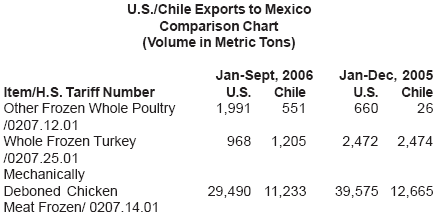



International Egg and Poultry Review
US - By the USDA's Agricultural Marketing Service - This is a weekly report looking at international developments concerning the poultry industry.Mexico
The signing of a safeguard agreement with the United States (U.S.) in July, 2003 that established a tariff rate quota for imports of chicken leg quarters from the U.S. has helped benefit Mexico’s poultry industry. Mexico’s estimated poultry meat production is forecast to increase 2.5% in 2007 to 2.641 MMT from 2006’s estimate of 2.576 MMT. Forecasts have been lowered from original estimates due to a combination of factors, including higher feed and production costs, competition from imports and higher costs for electricity, packaging material and transportation. Feed costs represent 55-60% of the total cost of production. Approximately 60% of the feedstuff usage is compromised of sorghum and yellow corn and 40% of this imported from the U.S.
With the expiration of the safeguard due in 2008, major producers have chosen to direct capital to improving technology along with sanitary and quality systems in an effort to better compete against imports and improve export prospects. Mexico does not yet have an equivalency agreement with the United States Depart of Agriculture’s (USDA) Food Safety Inspection Service that would allow for exports of domestically produced poultry meat and egg products to the U.S.
Chicken consumption in Mexico is forecast to increase in 2007 due to factors including population growth, affordability of chicken when compared to other meats, effective marketing campaigns, increased usage in processed food products and improved product quality. Increased consumer concerns about cholesterol and other health issues have also resulted in greater marketing opportunities for chicken meat. Even though consumers still prefer fresh whole chickens to chicken cuts, purchases of chicken cuts are slowly increasing. The increased demand is coming mostly in areas that serve higher income consumers.
Turkey meat consumption is also forecast to increase in Mexico to 218,000 MT in response to growing demand from the processing industry. Demand has increased on turkey meat in the form of cold cuts and on whole turkeys. Cooked hams made from blends of domestic pork and U.S. turkey thigh meat have been substantially cheaper than all-pork cooked hams.
Imports of both chicken and turkey meat are forecast to increase in 2007 in response to strong demand from Mexican food processors for further processing. Large meat processors prefer fresh, refrigerated product while medium to small processors tend to use frozen product. Even though the United States is the main supplier of chicken and turkey meat to Mexico with total poultry imports anticipated to increase 7% in 2007, Chile’s presence in the market is expected to increase as importers seek to diversify suppliers due in part to changing disease conditions in North America. Imports from Chile enter duty free under the Mexico-Chile Free Trade Agreement.
Source: USDA/FAS

Source: USDA/FAS

Source: USDA/FAS
To view the full report, including tables, please click here (PDF Format)








